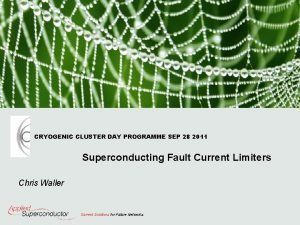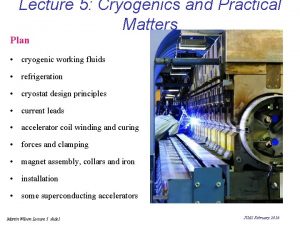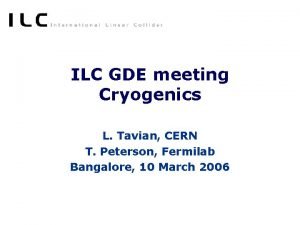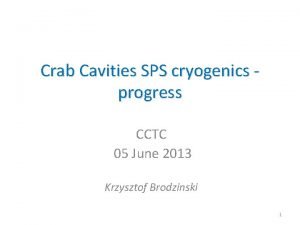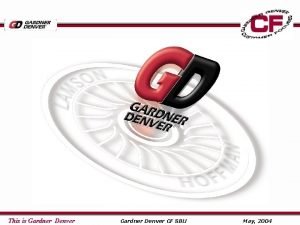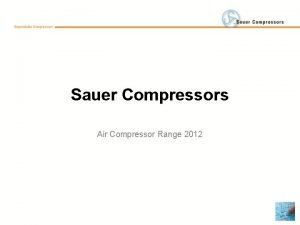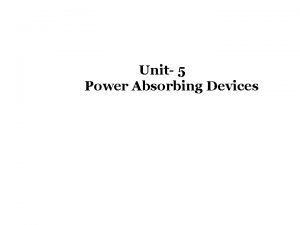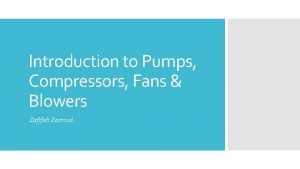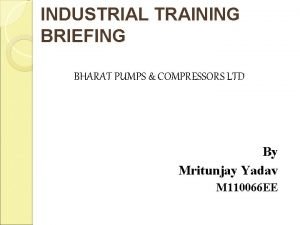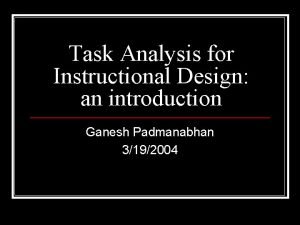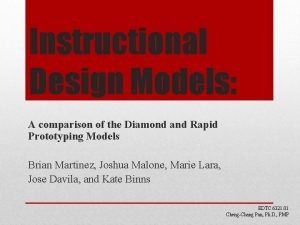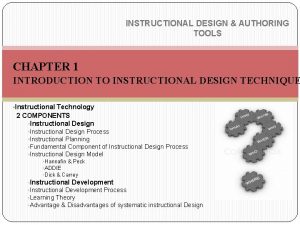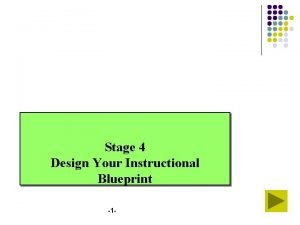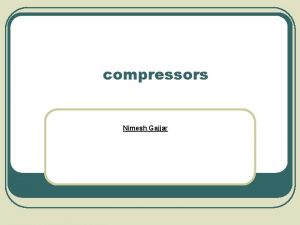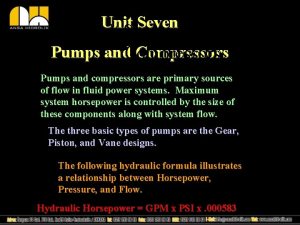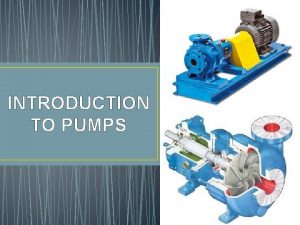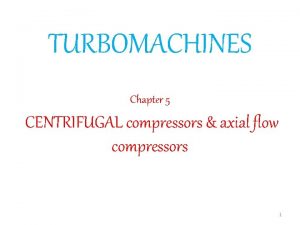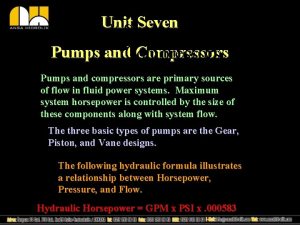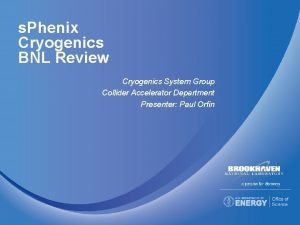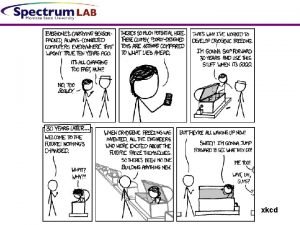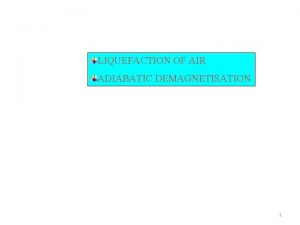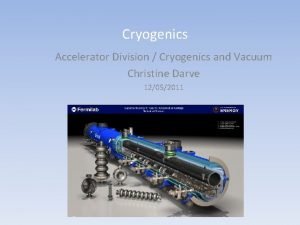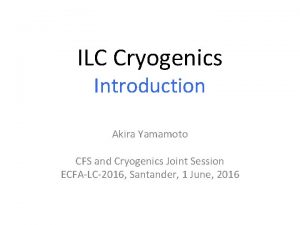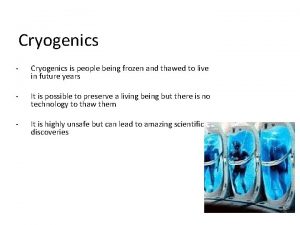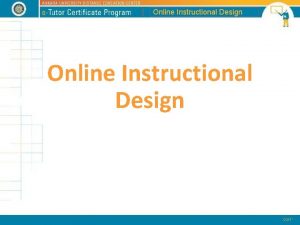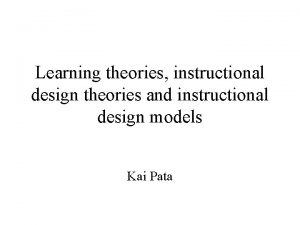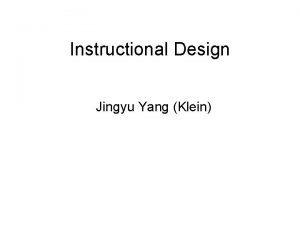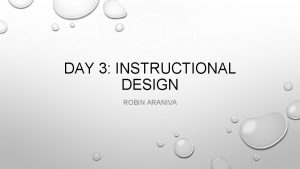Use of Linear Compressors in Cryogenics Instructional Design


















- Slides: 18

Use of Linear Compressors in Cryogenics Instructional Design Document STAM Interactive Solutions

Demo Outline (For reference) Topic Number Topic Name Page Type 1 Conventional Reciprocating Compressors Animated page 2 Linear Compressors Animated page 3 Working Principle of Linear Compressors Animated page 4 Moving Coil Linear Compressor Animated page 5 Moving Magnet Linear Compressor Animated page 6 Components of a Linear Compressor Animated page 7 Double Acting Linear Compressor Animated page

Cryogenic Engineering I & II Use of Linear Compressors in Cryogenics A compressor is a device which increases the pressure of fluid. A linear compressor is one which, unlike a conventional crank connecting rod mechanism, uses a linear reciprocating motor to drive the piston. This demo describes the working of a Linear Compressor.

Cryogenic Engineering I & II Use of Linear Compressors in Cryogenics Conventional Reciprocating Compressors Conventional reciprocating compressors have crank – connecting rod arrangements which convert motors rotational movement into the pistons linear movement to compress refrigerant. However, this results in alternating transverse forces resulting in undesirable vibrations. For animation, please refer to the ‘Alpha_Stirling. gif’.

Cryogenic Engineering I & II Use of Linear Compressors in Cryogenics Linear Compressors • To obtain cryogenic temperature, an object can either be placed in bath of liquid cryogen like Liquid Helium, Liquid Nitrogen or a cryocooler like Stirling cryocooler, Gifford-Mc. Mahon refrigerator, Pulse-Tube refrigerator. When liquid cryogens are used, the liquid bath has to be replenished periodically to compensate for the cryogen lost due to boil-off. • Cryocoolers eliminate these disadvantages. Cryocooler can either be used in isolation, or to recool the stored cryogen.

Cryogenic Engineering I & II Use of Linear Compressors in Cryogenics Working Principle of Linear Compressors • In a linear compressor, a current carrying copper coil is placed inside a magnetic field. • The Lorentz force thus developed is used to drive the connecting rod of the piston forward. • The direction of the Lorentz force is given by the left hand rule. • There are two flexure springs attached at two ends of the connecting rod. • The forward traverse of the connecting takes place until the Lorentz force is counterbalanced by the resistive forces applied by the flexure springs. • The torsional load of the springs limits the stroke of the compressor. • At this point the direction of the electric current is reversed the piston makes its return stroke. • The frequency of the forward and backward stroke is directly related to the frequency of the input alternating current.

Cryogenic Engineering I & II Use of Linear Compressors in Cryogenics Moving Coil Linear Compressor There are two types of Linear Compressor; Moving Magnet Linear Compressor and Moving Coil Linear Compressor: o In this arrangement, the current carrying copper coil is attached to a coil former which in turn is attached rigidly to the connecting rod of the compressor. o The permanent magnet is concentrically placed around the connecting rod. o The connecting rod slides through the magnet and thereby allowing relative motion between the magnet and the copper coil.

Cryogenic Engineering I & II Use of Linear Compressors in Cryogenics Moving Magnet Linear Compressor o This is a more commonly used arrangement. o In this arrangement, the permanent magnet is attached to the connecting rod of the piston. o The permanent magnet, therefore, makes a reciprocating motion along with the piston. o The copper coil resides on the stator of the compressor and is stationary.

Cryogenic Engineering I & II Use of Linear Compressors in Cryogenics Components of a Linear Compressor • Piston o It is used to compress the working fluid. o As piston rings and lubricating oils cannot be used at cryogenic temperatures, low friction coating is applied on the piston to reduce its coefficient of friction. o Typical low friction material is PTFE Rulon polymer which is stuck on the piston and then grounded. o Very small clearances are maintained between the piston and the cylinder walls to prevent leakages across the piston. • Connecting Rod Piston

Cryogenic Engineering I & II Use of Linear Compressors in Cryogenics Components of a Linear Compressor • Flexure Spring o The flexure spring provides the counter-balancing force against the Lorentz force. o They are in the form of disk with spiral grooves going radially inwards. o The flexure springs are rigidly attached to the connecting rod. o The spring is made of Beryllium Copper. o Due to the linear motion of the connecting rod, the flexure spring is deformed resulting in bending and torsional stresses. o The working stress is less that the fatigue stress of the material. Flexure spring

Cryogenic Engineering I & II Use of Linear Compressors in Cryogenics Components of a Linear Compressor • Coil Arrangement o Enameled copper wire is wound on the coil former. o In case of moving magnet arrangement, the copper wire is directly connected to the alternating current power source. o In case of moving coil arrangement, the coil former is rigidly attached to the connecting rod. Coil former

Cryogenic Engineering I & II Use of Linear Compressors in Cryogenics Components of a Linear Compressor • Permanent Magnet Arrangement o The magnet is sandwiched between the yoke and the pole piece. o The yoke and the pole piece helps in concentrating the magnetic field in the air gap between the magnet and the coil. o In case of the moving coil arrangement, the pole piece, magnet and the yoke is concentrically placed about the connecting rod. Pole piece yoke

Cryogenic Engineering I & II Use of Linear Compressors in Cryogenics Double Acting Linear Compressor • The forward and backward stroke of the piston results in alternating unbalanced axial forces which causes vibrations. • To reduce such unbalanced forces, a double acting 180 o out-of-phase compressor can be used.

Cryogenic Engineering I & II Use of Linear Compressors in Cryogenics Resources Books: 1. H. C. Roters: “Electromagnetic Devices” 2. David J. griffiths: ‘Introduction to Electrodynamics’ Links: 1. 2. 3. http: //en. wikipedia. org/wiki/Linear_compressor http: //www. eng. ox. ac. uk/cryogenics/linearcomp. html http: //www. eng. ox. ac. uk/cryogenics/papers/Preprint_Valved. Comp. pdf

Cryogenic Engineering I & II Use of Linear Compressors in Cryogenics A linear compression system uses a Closed Cycle an Open Cycle Neither Depends on the working fluid

Cryogenic Engineering I & II Use of Linear Compressors in Cryogenics In a Linear Compressor, the piston produces no sideward forces on the casing the piston produces sideward forces that vary with the piston movement the piston produces sideward forces that are independent of the piston location the motor directly connected to the piston moves along a linear track to compress refrigerant

Cryogenic Engineering I & II Use of Linear Compressors in Cryogenics The governing equations for the linear motor include Fleming’s Left Hand rule Lorentz’ Force law Faraday’s Law of Electromagnetic Induction

Cryogenic Engineering I & II Use of Linear Compressors in Cryogenics The flexure bearing should have low radial and high axial stiffness high radial and high axial stiffness low radial and low axial stiffness high radial and low axial stiffness
 Cryogenics palm harbor
Cryogenics palm harbor Eleet cryogenics
Eleet cryogenics What is the difference between 29 028 and 1 312
What is the difference between 29 028 and 1 312 Practical cryogenics
Practical cryogenics Acd cryogenics
Acd cryogenics Sps cryogenics
Sps cryogenics Gardner denver corporate office
Gardner denver corporate office Lamellar valve (3rd stage)
Lamellar valve (3rd stage) Pumps and compressors are power absorbing devices
Pumps and compressors are power absorbing devices Fans blowers and compressors
Fans blowers and compressors Bharat pumps and compressors
Bharat pumps and compressors Fans blowers and compressors
Fans blowers and compressors Task analysis instructional design
Task analysis instructional design Diamond model of curriculum development
Diamond model of curriculum development Instructional design authoring tools
Instructional design authoring tools Dynamic instructional design model
Dynamic instructional design model Benefits of assure model
Benefits of assure model Concept of teaching
Concept of teaching Assure öğretim tasarımı modeli
Assure öğretim tasarımı modeli
